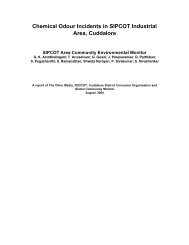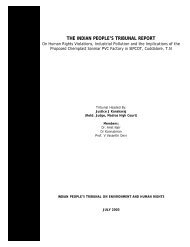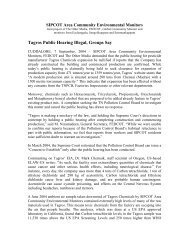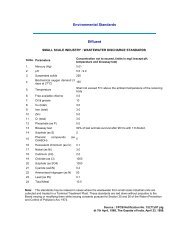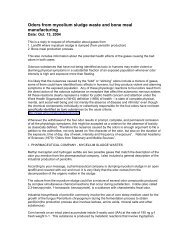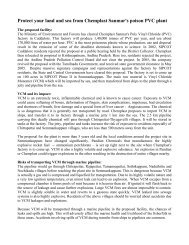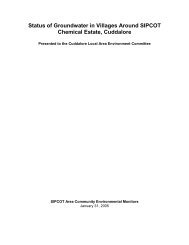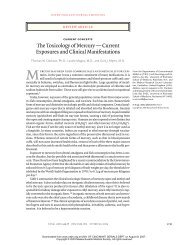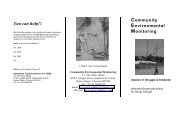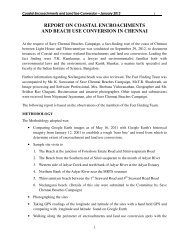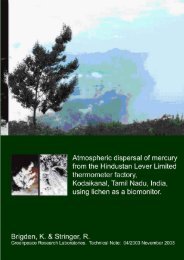Majority Report of the Committee Constituted to ... - Forest Rights Act
Majority Report of the Committee Constituted to ... - Forest Rights Act
Majority Report of the Committee Constituted to ... - Forest Rights Act
You also want an ePaper? Increase the reach of your titles
YUMPU automatically turns print PDFs into web optimized ePapers that Google loves.
Traditional system <strong>of</strong> Agriculture that prevailed among <strong>the</strong> local<br />
Oriya communities in this area.<br />
I. Cultivation in forest land.<br />
21. `Kandhachas’ is a cultivation that needed clearing <strong>of</strong> big<br />
patches <strong>of</strong> forest for cultivation <strong>of</strong> paddy on a co-operative basis. The<br />
cultiva<strong>to</strong>rs used <strong>to</strong> reside <strong>the</strong>re temporarily and carry on agriculture. As<br />
soon as <strong>the</strong> agricultural activity is complete <strong>the</strong>y come back <strong>to</strong> <strong>the</strong>ir<br />
villages which are outside <strong>the</strong> forest leaving one or two people <strong>to</strong> watch<br />
over <strong>the</strong> crop. This supervision is carried out on a rotation basis. When a<br />
particular operation is needed <strong>to</strong> be done <strong>the</strong>n <strong>the</strong> entire group moves <strong>to</strong><br />
<strong>the</strong> spot <strong>to</strong> construct temporary structures. However, different people<br />
take up different activities such as fishing, repair <strong>of</strong> implements etc. It is<br />
however unders<strong>to</strong>od that <strong>the</strong> crop belongs <strong>to</strong> <strong>the</strong> entire group and <strong>the</strong>y<br />
share equally. The ‘Khanda’ is known after <strong>the</strong> name <strong>of</strong> <strong>the</strong> group leader.<br />
Some <strong>of</strong> <strong>the</strong>se ‘Khandas’ are about hundreds <strong>of</strong> acres in extent and <strong>the</strong><br />
membership <strong>of</strong> <strong>the</strong> group goes up from 50-60 in some cases. Hence, <strong>the</strong><br />
land is held un-fragmented in this cus<strong>to</strong>mary practice. However, during<br />
<strong>the</strong> settlement ‘Khandha Chasis’ have been recorded as encroachers on<br />
government land, as <strong>the</strong>y have entered <strong>the</strong> forest block. It is an ancient<br />
form <strong>of</strong> cultivation practice and uses <strong>the</strong> fertility <strong>of</strong> forest soil <strong>to</strong> grow<br />
paddy. (Final report on settlement <strong>of</strong> Kujang <strong>Forest</strong> Block 1959- 66,<br />
Annexure B3 ,page 39).<br />
II. His<strong>to</strong>ry <strong>of</strong> Betel Vine Cultivation in Kujang Estate<br />
22. A his<strong>to</strong>ry <strong>of</strong> <strong>the</strong> cultivation <strong>of</strong> betel vine is quite old, going back<br />
<strong>to</strong> <strong>the</strong> 19th century and is reported (Bihar and Orissa Gazetteer,<br />
Cuttack, 1933, page 89-90, Annexure B2) as follows-<br />
“The cultivation <strong>of</strong> <strong>the</strong> climbing vine called betel (piper betel) <strong>the</strong><br />
leaves <strong>of</strong> which are used <strong>to</strong> wrap up supari chewed by Indians <strong>of</strong> all<br />
ranks and classes, is not extensive. It was introduced by some men<br />
<strong>of</strong> Barua caste who came from Bengal and settled down in Cuttack.<br />
It is still grown for <strong>the</strong> most part by men <strong>of</strong> this caste , but it is no<br />
longer confined <strong>to</strong> <strong>the</strong>m as <strong>the</strong> pr<strong>of</strong>its <strong>of</strong> <strong>the</strong> crop have attracted<br />
o<strong>the</strong>r castes, and now Khandaits, and indeed even Brahmans<br />
cultivate it”<br />
The finest betel were reported <strong>to</strong> have been grown at Barkud in <strong>the</strong><br />
Kujang estate, where <strong>the</strong> immigrant Baruas first settled ; and <strong>the</strong> greater<br />
portion <strong>of</strong> <strong>the</strong> district, especially <strong>the</strong> markets in <strong>the</strong> Kendrapara



